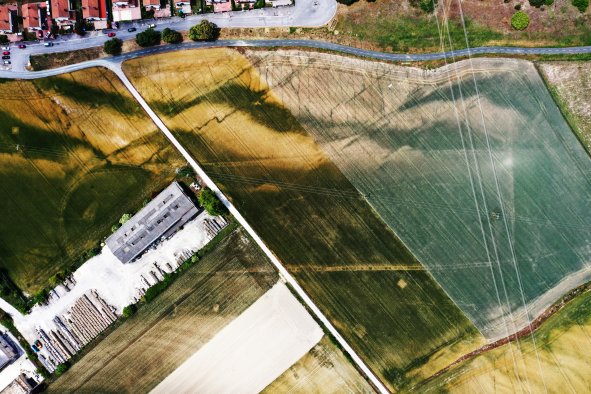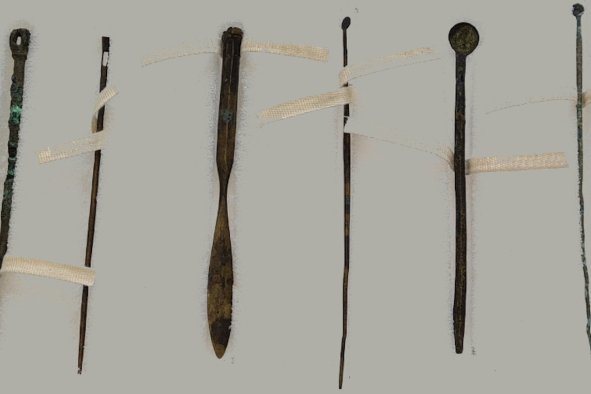Archaeologists working in the ruins of Pompeii have made an unprecedented discovery that casts new light on the final moments of the doomed ancient city.
A study published in the journal Frontiers in Earth Science found that earthquakes may have played a significant role in the destruction of the Roman settlement and the death of its inhabitants during the infamous eruption of Mount Vesuvius in A.D. 79. This conclusion stems from the identification of "peculiar" building collapses and an intriguing pair of skeletons.
"Our study broadens the panorama of the damaging events and causes of death in Pompeii during the A.D. 79 eruption," Domenico Sparice, a volcanologist at INGV-Osservatorio Vesuviano and first author of the study, told Newsweek.
The ancient city, located at the base of the volcano in the Campania region of southern Italy, is one of the most famous archaeological sites in the world. The explosive eruption of Vesuvius destroyed Pompeii, burying the city beneath a layer of ash and pumice (a type of volcanic rock), which preserved the remains like a time capsule.
The destruction of Pompeii has so far been attributed to the effects of volcanic phenomena. These include the accumulation of volcanic debris on the city's buildings and the impact of pyroclastic flows—fast-moving currents of hot gas and volcanic matter. But the potential role of seismic activity, significant levels of which can accompany explosive eruptions, has been neglected, according to the researchers.
Pliny the Younger documented seismic activity during the catastrophe in his letters to the Roman historian Tacitus, the only surviving eyewitness account of the event.
"Pliny reported the occurrence of shakings during the night of the first day of the eruption and violent seismic shocks at the daybreak of the second day," Sparice said.
The possible effects of such seismic activity has only been the subject of speculation by a few scholars. But never before has damage associated with earthquakes occurring during the eruption been reported in Pompeii—until now.
"Our study, for the first time, found evidence of...significant seismicity which caused building collapses and deaths," Sparice said.
The study is the first to tackle the complex task of reporting on the effects of earthquakes that occurred around the same time as the eruption. Studying such phenomena is challenging due to the possibility of volcanic and seismic effects happening concurrently or in quick succession. This could mean that the effects of volcanic phenomena overshadow the impacts of earthquakes or vice versa.
"These complexities are like a jigsaw puzzle in which all the pieces must fit together to unravel the complete picture," Sparice said in a press release. "We proved that seismicity during the eruption played a significant role in the destruction of Pompeii and, possibly, influenced the choices of the Pompeiians who faced an inevitable death."
During a recent excavation in the Insula dei Casti Amanti, located in the central part of Pompeii, researchers uncovered intriguing evidence of building collapses that apparently overwhelmed two individuals.
"[The study] all stemmed from the discovery during ongoing excavations in the so-called Insula dei Casti Amanti, one of the most important parts of Pompeii, of building collapses having peculiar characteristics that, at first glance, were inconsistent with the effects of the volcanic phenomena as described in the volcanological literature devoted to [the city]," Sparice told Newsweek.
"Driven by curiosity, we tried to figure out if there was an alternative explanation."
The team subsequently found skeletons of two male individuals, both around 50 years of age at death, displaying evidence of severe fractures and traumatic injuries.
According to the authors, the peculiar building collapse and the deaths of these two individuals are consistent with and can be explained by seismic activity rather than volcanic phenomena.
During the eruption, pumice lapilli—small volcanic rock and ash particles—rained down on the city for hours, forcing people to seek shelter. At some point, the eruption seems to have paused, during which time initial survivors may have believed they were safe. But the occurrence of strong earthquakes appear to have only added to the devastation.
"The people who did not flee their shelters were possibly overwhelmed by earthquake-induced collapses of already overburdened buildings. This was the fate of the two individuals we recovered," study co-author Valeria Amoretti, an anthropologist who heads the Applied Research Laboratory of Pompeii Archaeological Park, said in the press release.
The positioning of the two skeletons suggests that the first individual was suddenly crushed by the collapse of a large wall fragment, resulting in severe injuries that likely caused immediate death. The second individual, on the other hand, was also crushed by collapsing walls but appears to have realized the danger and tried to protect himself with a wooden object. The researchers detected faint traces of this object in the volcanic deposits.
The evidence indicates that these individuals did not die from inhaling ash or extreme heat. For example, the remains were found on top of the pumice lapilli, rather than under it.
This suggests that the pair survived the first phase of the eruption, only to be overwhelmed by collapsing walls during the temporary pause in volcanic activity and before the arrival of pyroclastic flows, according to the study. The crush injuries of the skeletons also resemble those seen in individuals involved in modern earthquakes.
"New insight into the destruction of Pompeii gets us very close to the experience of the people who lived here 2,000 years ago," study co-author Gabriel Zuchtriegel, director of the Pompeii Archaeological Park, said in the press release. "The choices they made as well as the dynamics of the events, which remain a focus of our research, decided over life and death in the last hours of the city's existence."
Do you have a tip on a science story that Newsweek should be covering? Do you have a question about archaeology? Let us know via science@newsweek.com.
Disclaimer: The copyright of this article belongs to the original author. Reposting this article is solely for the purpose of information dissemination and does not constitute any investment advice. If there is any infringement, please contact us immediately. We will make corrections or deletions as necessary. Thank you.



